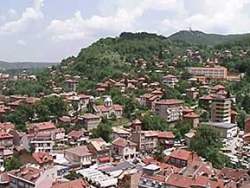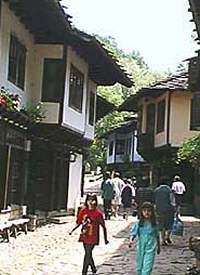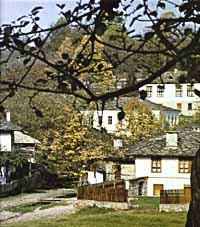|
|
| |
BULGARIA
GABROVO
The town of Gabrovo is situated in Northern Bulgaria, along the River Yantra, in the north Sredna Stara Planina mountain spur, 392 m above sea-level. Gabrovo is 220 km north-east from the city of Sofia. In the immediate vicinity of Gabrovo is the geographical centre of Bulgaria. Because of its locality the town is a busy road junction.
 Due to its clean mountain air, historical and ethnographical complexes Gabrovo has become an attractive tourist centre. Municipality and the surrounding area is considered to be one of the most ecologically clean regions in Bulgaria. The rich flora and fauna come to prove that. Some of the best hunting trophies such as bear, red deer and mouflon can be found in the game reserves.
There are some places of interest, which are of national and international importance.
Such place is The House of Humour and Satire. There you can see different art and ethnographical exhibitions and collections of African ritual and carnival masks and accessories. Thousands of world famous humourists from more than 150 countries have visited The House of Humour and Satire during the Festivals of Humour and Satire.
 The most picturesque place in Gabrovo is the architectural and ethnographical complex Etur - a unique open-air museum. The Bulgarian Renaissance atmosphere is reserved there in the old workshops of traditional Bulgarian arts and crafts. The visitors can watch the craftsmen doing everything by their own hands and by water-driven machinery. There are some hotels, restaurants, and taverns available. The visitors like them for the Bulgarian traditions in cooking are still reserved there.
Near Gabrovo is the 600-year-old village Bozhentsi - an architectural and historical reserve. Bozhentsi is located in a pretty valley, and all its authentic houses date back to The Renaissance period. Bozhentsi is an excellent place for individual and family tourism.
 Ouzana is a mountain locality near Gabrovo. The geographical centre of Bulgaria is found here. Ouzana is a suitable place for your winter and summer holiday. Here you can do some skiing, horse-riding, mountain-climbing, etc.
The distance from Lyulyatsite Resort (The Lilac Shrubs) to Gabrovo is 15 km. The resort is famous for its favourable effects on some cases of allergy, hypertonia and chronic diseases of respiratory system.
A lot of theatrical, musical and folklore professional groups, puppet-show, pantomime theatre, Gabrovo Chamber Orchestra, "Gabrovo" - Swing Dixie Band and a lot of others contribute to the cultural life in Gabrovo.
|
|
|
Festivals and Fairs
The Great Koprivshtitza Folklore Festival
The Great Koprivshtitza Folklore Festival is Bulgaria's largest gathering of traditional musicians and singers and is a cross between a pop festival and a medieval fair. It is a sight that knows no equal: thousands of musicians and singers making the hillside above the picturesque village of Koprivshtitza their home for a few days. Coupled with this you have the colourful stalls of the traders and the thousands of visitors who come for the festival.
This is Bulgarian music as it was always played, played by the ancestors of those who first played it. But perhaps it is what happens on the periphery that is the most authentic. Strolling players or soloists, simply playing for the sheer enjoyment. forming new bonds with other musicians or just letting their music ring out over the hillside.
The Bourgas International Folk Festival
The Bourgas International Folk Festival, held annually, attracts a host of Bulgarian and international artists and is held in the second half of August.
The Kazanluk Festival
The Kazanluk Festival of the Roses is held annually in early June, and has grown from a local to an international event. Not only are the roses, Kazanluk's main industry, in full flower. but the town itself blossoms while visitors enjoy the "Rose Picnic" and all the fun of a folklore festival, with its costumes, songs and dance. Should you still have the energy left, you can always visit the old factories where the rose oil is extracted.
St. Trifon's Day
In the agricultural calendar, St. Trifon's Day celebrates the pruning of the vines, and is held on February 14.
Kukerov Den
On the first Sunday before Lent, Kukerov Den celebrates the start of the agricultural year, and all over Bulgaria you can witness processions led by the dancing. leaping Kukeri dressed in colourful masks and costumes.
Baba Marta
Baba Marta is celebrated on March 1 when peasant house-holds brush out the winter cobwebs with a traditional spring clean. and people offer each other tokens of good luck called martenitsas.
Kukeri
Like western countries. the Bulgarian calendar is dotted with important feast days and festivals. The festival of the Kukeri re-enacts ancient surovaki rites to ward off evil spirits and Kukeri fertility rites. Although only held once every five years, it brings together dancers from all over Bulgaria in a rainbow of colours and styles.
St. Lazarus Day
Lazaruvane is also celebrated in spring on St. Lazarus Day, and here village girls considered fit for marriage perform ritual songs and dances.
St. Konstantin and St. Elena Day
The coming of summer is traditionally celebrated on St. Konstantin and St. Elena Day on May 21, and in some of the remoter villages in the Stranzha hills fire dancing, dancing on heated coals, is still practised in celebration of summer's arrival. Ethnologists have suggested that this practice is directly descended from Dionysina rites of the ancient Thracian.
|